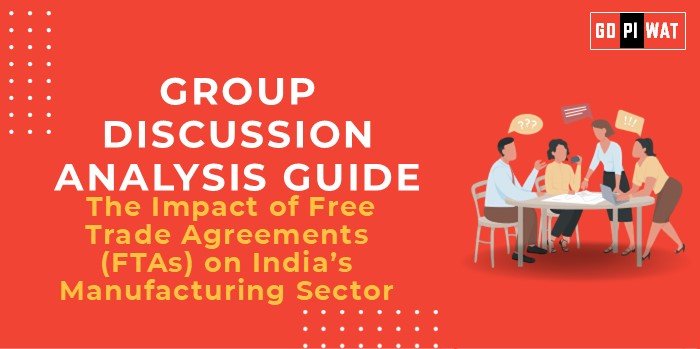📋 Group Discussion Analysis Guide
📝 Topic: The Impact of Free Trade Agreements (FTAs) on India’s Manufacturing Sector
🌐 Introduction to the Topic
🌏 Opening Context: Free Trade Agreements (FTAs) are pivotal instruments in global trade, fostering economic integration and facilitating market access. For India, FTAs hold strategic importance for boosting the manufacturing sector, a cornerstone of the “Make in India” initiative aimed at revitalizing domestic production and enhancing exports.
📜 Topic Background: India has engaged in 14 comprehensive FTAs with countries and regional blocs, including ASEAN, Japan, South Korea, and the UAE. These agreements aim to enhance economic opportunities while also highlighting challenges related to domestic sector resilience and global competitiveness.
📊 Quick Facts and Key Statistics
- 📄 FTAs Signed: 14 comprehensive agreements with key partners.
- 🏭 Manufacturing Share: Contributes ~13% to India’s GDP (2023).
- 📈 Export Growth: Merchandise exports to FTA countries grew by 20.75% over the last five years.
- 📉 Trade Deficit: $30 billion trade deficit with FTA partners in the first half of 2023, up from $27.9 billion the previous year.
- 👷 Employment Impact: The sector employs ~35.6 million people, with potential for significant growth.
🎯 Stakeholders and Their Roles
- 🏛️ Government: Shapes FTAs, implements domestic incentives like PLI schemes, and addresses trade imbalances.
- 💼 Private Manufacturers: Adapt strategies to leverage FTA advantages while addressing import competition.
- 📊 Trade Bodies: Advocate for balanced agreements and safeguard domestic interests.
- 🌍 Global Partners: Influence tariff reductions and trade regulations during negotiations.
🏆 Achievements and Challenges
🔑 Achievements
- 📈 Export Growth: Merchandise exports to FTA countries have seen a 20.75% rise in five years, showcasing improved market access.
- 🔧 Technology Transfer: FTAs have facilitated advanced technology integration in sectors like automotive and electronics.
- 🏭 Sectoral Diversification: Significant growth observed in textiles, pharmaceuticals, and specialty chemicals.
⚠️ Challenges
- 📉 Trade Deficit: A $30 billion trade deficit with FTA partners in early 2023 highlights competitiveness challenges.
- 🏭 Competition Pressure: Sectors such as steel and electronics face competition from cheaper imports.
- 📜 Non-Tariff Barriers: Complex standards and certification processes undermine potential gains.
🌍 Global Comparisons
- 🇻🇳 Vietnam: Leveraged FTAs like CPTPP to boost exports by over 20%.
- 🇲🇽 Mexico: Used NAFTA to attract FDI, driving automotive manufacturing growth.
📖 Case Studies
- 👕 Textiles in Tamil Nadu: EU concessions have bolstered exports, creating rural employment opportunities.
- 💊 Pharmaceuticals in Gujarat: FTAs facilitated access to Southeast Asian markets.
🗣️ Structured Arguments for Discussion
- ✅ Supporting Stance: “FTAs open new markets, foster technology transfer, and drive export-led growth, aligning with India’s manufacturing ambitions.”
- ❌ Opposing Stance: “India’s trade deficits and heightened import competition highlight vulnerabilities in the manufacturing sector under FTAs.”
- ⚖️ Balanced Perspective: “While FTAs offer immense potential, realizing their benefits requires strengthening domestic competitiveness and strategic negotiations.”
💡 Effective Discussion Approaches
🌟 Opening Approaches
- 📊 “Merchandise exports to FTA nations grew by 20.75% over five years, yet trade deficits with these partners remain a challenge.”
- 🌍 “Vietnam’s success with FTAs offers valuable lessons for India’s manufacturing growth.”
🎯 Counter-Argument Handling
- 📈 Discuss government interventions like PLI schemes to enhance competitiveness.
- 🔄 Highlight long-term benefits of global integration.
📊 Strategic Analysis of Strengths and Weaknesses
🔍 SWOT Analysis
- 💪 Strengths: Large labor force, diverse industrial base, growing demand for Indian exports.
- 📉 Weaknesses: Infrastructure deficiencies, reliance on imports for key inputs.
- 🌟 Opportunities: “China Plus One” sourcing strategy, growing demand in emerging markets.
- ⚠️ Threats: Non-tariff barriers, global economic volatility.
📚 Connecting with B-School Applications
- 🧠 Real-World Applications: Link FTAs to discussions on global supply chains, economic policy, and international trade strategy.
- 📋 Sample Interview Questions:
- 🤔 “How can India minimize trade deficits while leveraging FTA advantages?”
- ⚖️ “What role do FTAs play in strengthening India’s manufacturing ecosystem?”
- 💡 Insights for Students:
- 📦 Consider FTAs as case studies for operations optimization.
- 🌍 Explore market strategy development and trade policy research.


